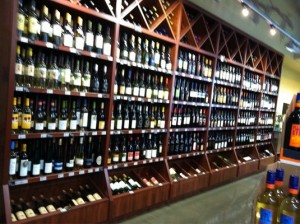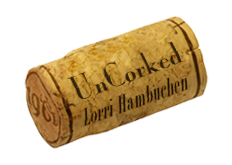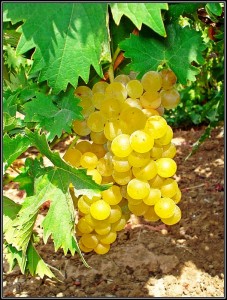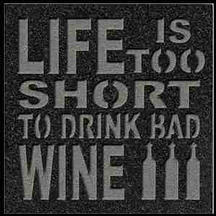by Lorri | Mar 28, 2012 | UnCorked
 Finding the perfect wine to enjoy with your meal can range from an all-out ordeal to a matter of blind chance. With the vast array of wine and food choices, the combinations are seemingly endless.
Finding the perfect wine to enjoy with your meal can range from an all-out ordeal to a matter of blind chance. With the vast array of wine and food choices, the combinations are seemingly endless.
However, some wines complement a wider variety of foods than others. Committing these top 10 food-friendly wines to memory (or at least making a list to keep handy) can help ease the uncertainty when faced with a wine list at a restaurant or picking up a bottle to go with dinner at home.
Dry rose deserves recognition for its versatility. This style matches effortlessly with salads or mildly spiced dishes, and makes an all-around safe pick for almost any light spring or summer menu.
THE VALUE
- 2010 Presqu’ile Winery Dry Rose, California (about $21 retail)
THE SPLURGE
- 2010 Domaine Serene Dry Rose, Oregon (about $34 retail)
“Naked” chardonnay is more approachable than its overbearing, extremely oaky cousins that can overwhelm even the most robust dishes. Unoaked chardonnay pairs well with lighter foods such as chicken, salmon and some pork dishes.
THE VALUE
- 2011 Simply Naked Unoaked Chardonnay, California (about $10 retail)
THE SPLURGE
- 2010 Mer Soleil Silver Chardonnay, California (about $40 retail)
Light-bodied whites such as sauvignon blanc, semillon, Riesling, pinot blanc and pinot grigio are safe bets with almost any salad or vegetarian dish. They also pair well with fish, chicken, pork and pasta. Pinot grigio’s easy drinking style and light body make it an ideal starter wine, but it can carry an entire meal too.
THE VALUES
- 2011 Mezzacorona Pinot Grigio, Italy (about $10 retail)
- 2010 Trimbach Pinot Blanc, France (about $20 retail)
THE SPLURGES
- 2010 King Estates Acrobat Pinot Gris, Oregon (about $16 retail)
- 2011 Stoneleigh Sauvignon Blanc, New Zealand (about $24 retail)
Albarino is a sure bet with almost any fish dish. This luscious dry white Spanish wine also works well with rice and pasta dishes.
THE VALUE
- 2011 Martin Codax Albarino, Spain (about $19 retail)
THE SPLURGE
- 2011 Mar de Frades Albarino, Spain (about $28 retail)
Merlot is the red wine known for not only its crowd-pleasing fruity style but also its ease when matched with a wide range of foods. It is a safe bet for dishes with more body, spice and weight.
THE VALUE
- 2010 Michel Lynch Merlot, France (about $12 retail)
THE SPLURGE
- 2009 Rutherford Ranch Merlot, California (about $20 retail)
The light fruity style of pinot noir is a sound choice for lighter meats, pastas and fish.
THE VALUE
- 2009 Mirassou Pinot Noir, California (about $12 retail)
THE SPLURGE
- 2009 Ponzi Vineyards Tavola Pinot Noir, California (about $27 retail)
by Lorri | Mar 21, 2012 | UnCorked
 New Zealand is known for its exceptional-quality sauvignon blanc, but what it may be best remembered for 30 years from now is transforming the way the wine world seals its product.
New Zealand is known for its exceptional-quality sauvignon blanc, but what it may be best remembered for 30 years from now is transforming the way the wine world seals its product.
New Zealand’s winemakers have been at the forefront of helping their peers say goodbye to cork taint by replacing the natural-fiber closures with screw caps.
The process began about 40 years ago in neighboring Australia, when Peter Wall, production director of Yalumba contacted French manufacturer, Le Bouchon Mecanique (literally translated as The Mechanical Stopper) in a quest to eliminate cork taint in his wines and maintain freshness.
The French food industry had been using a screw top since the middle of the 19th century, but in 1959 a specific cap was adapted for wine bottles.
While the French may have led the way in design and production, their customers were less accepting of a wine closure beyond the traditional natural cork, as were wine drinkers around the world.
However, in 2000, when a group of Australia’s Clare Valley winemakers began using this modern seal for premium wines, others took notice.
This immediately got the attention of New Zealand winemakers, who were already researching a solution to taint caused by cork closures.
In February 2001, Marlborough winemakers began investigating using the screw cap as a seal, as were winemakers outside the region. In a logical evolution, they joined forces to create the New Zealand Screwcap Initiative.
The first commercial release of New Zealand wine with a screw cap was by Kim Crawford, quickly followed by Jackson Estate and Villa Maria. Today, it’s estimated that wines in screw-cap bottles represent about 85 percent of New Zealand’s production.
The initiative continues to gain momentum as winemakers around the world switch to this closure.
THE VALUE
- 2011 Clifford Bay Sauvignon Blanc, New Zealand, (about $12 retail)
THE SPLURGE
- 2011 Spy Valley Sauvignon Blanc, New Zealand (about $18 retail)
by Lorri | Mar 16, 2012 | UnCorked
 March marks Uncorked’s seventh anniversary — reinforcing the feeling that time certainly flies when you’re having fun.
March marks Uncorked’s seventh anniversary — reinforcing the feeling that time certainly flies when you’re having fun.
During the past year we’ve explored everything from flying corks to popcorn pairings.
My goal in writing this column is (and always has been) to offer honest recommendations of wines available in Arkansas, and possibly more importantly, to make the subject of wine in general approachable to everyone. Whether you’re just beginning to explore the world of wine or you’re a dedicated oenophile, my hope is this column offers something for everyone interested in wine.
Feedback, questions, ideas and column suggestions are always welcome, so please keep the cards and letters coming.
Below are some of my favorite Values and Splurges from the past year.
For a complete list of wines featured in Uncorked in the past year, e-mail uncorked@lorrihambuchen.com or write Uncorked, c/o the Arkansas Democrat-Gazette, P.O. Box 2221, Little Rock, Ark. 72203. The list is great to have on hand for a quick and easy buying reference.
THE VALUES
- 2010 Lindeman’s Bin 77 Semillon-Chardonnay, Australia (about $9 retail)
- 2010 Cupcake Central Coast Merlot, California (about $10 retail)
- 2010 Fontana Candida Frascati, Italy (about $8 retail)
- 2010 Tamas Estates Pinot Grigio, California (about $12 retail)
- 2009 Cline Cellars Sonoma County Syrah, California (about $12 retail)
THE SPLURGES
- 2009 Firesteed Riesling, Oregon (about $19 retail)
- 2009 Presqu’ile Pinot Noir, California (about $48 retail)
- 2010 A to Z Pinot Gris, Oregon (about $17 retail)
- 2009 Bell Wine Cellars Yountville Merlot, California (about $36 retail)
- 2009 Rocca Delle Macie Chianti Classico, Italy (about $28 retail)
by Lorri | Mar 7, 2012 | UnCorked
 For years dry wines have been viewed as the “it” wines. But it seems Americans are sweetening their palates. Muscat is edging in as one of the most sought-after wines in the world. According to A.C. Nielsen data this sweet trend resulted in a 156.3 percent increase in sweet white wine volume in 2010.
For years dry wines have been viewed as the “it” wines. But it seems Americans are sweetening their palates. Muscat is edging in as one of the most sought-after wines in the world. According to A.C. Nielsen data this sweet trend resulted in a 156.3 percent increase in sweet white wine volume in 2010.
That’s a lot of consumers going to the sweet side.
The muscat grape, unlike many other wine grapes, is also enjoyed as a table grape. It has a distinctive flavor. If you’ve enjoyed it as a table grape, you’ll most likely instantly recognize the flavor as a wine.
The grape color ranges from white to brown to almost black and can be made into numerous styles ranging from sparkling white to the rich, dark fortified wines of Australia.
The best known are muscat blanc a petits grains (muscat blanc for short) and muscat of Alexandria. The muscat blanc grape is the oldest variety and creates the most concentrated grape flavors. It produces wines both dry and sweet. Muscat of Alexandria is used for intense dessert-style sweet wines. Muscat’s light white styles are drawing the attention of wine drinkers not only for the delectable taste of honey, peach and almond but consumer-friendly price tags.
THE VALUES
- NV Yellowtail Moscato, Australia (about $10 retail)
- 2011 Zonin Moscato, Italy (about $10 retail)
- 2011 Cavit Moscato, Italy (about $11 retail)
- 2011 Mezzacorona Moscato, Italy (about $11 retail)
- 2011 Bella Sera Moscato, Italy (about $9 retail)
THE SPLURGES
- 2009 Hugel Muscat, France (about $26 retail)
- 2011 Folonari Moscato, Italy (about $14 retail)
- 2011 Voga Moscato, Italy (about $15 retail)
by Lorri | Feb 29, 2012 | UnCorked
 Judging the quality of a wine is essential to its enjoyment, and understanding quality starts with a simple question: Does the wine smell clean? Whether you are a beginner or expert, your nose will quickly guide you.
Judging the quality of a wine is essential to its enjoyment, and understanding quality starts with a simple question: Does the wine smell clean? Whether you are a beginner or expert, your nose will quickly guide you.
Twenty years ago, poor quality, unclean wines were more commonplace, but with today’s technology only a minuscule amount of bottles are faulty because of an error in the wine-making process. A modern wine that is in good condition will not have even a slight smell of musty basements, mold, rotten eggs or vinegar.
If you do detect one of these aromas, the culprit, most likely, is the cork or improper storage conditions along the journey from the winery to your glass. Following are some common problems and ways to identify them.
CORK TAINT/CORKED WINES
Corked wine, or cork taint, as the flaw is also called, is one of the most obvious defects. The wine will exhibit musty aromas like a moldy, damp basement or wet cardboard and newspapers. Cork taint is the most common wine fault and is thought to affect up to 10 percent of all wines bottled in the world.
Taint is caused by cork infected with a fungus producing 2,4,6-trichloroanisole (TCA). When this chemical comes in contact with the wine, it imparts musty and moldy aromas. Research suggests there may be a connection between the process of chlorine bleaching the corks and the development of the fungus.
In the late 1990s cork taint forced many wine producers to seek alternate closures, including screw caps and synthetic corks. Because the TCA fungus is not able to harbor in screw tops, crown caps or other noncork closures, they are safe alternatives for avoiding faulty wines caused by an unlucky draw of a tainted cork.
OXIDATION
Oxidation is the result of a wine being exposed to air and is usually caused by a faulty cork.
Oxidized wines are simple to detect, with dull or stale fruit aromas and flavors. These wines will have a brownish color because of the contact with oxygen, much as a cut apple will brown when exposed to air. Keep in mind a few wines are intentionally oxidized during the making, such as sherry and port. But for the others, oxygen is not a wine’s friend, either in the bottle or during wine making.
VOLATILE ACIDITY
Though rare in commercial wineries, volatile acidity occurs from poor hygiene or prolonged undesirable temperatures during winemaking. It is more common for home winemakers. Volatile acidity is most often caused by bacteria in the wine, creating acetic acid. It is most easily recognized by the aromas of vinegar or nail polish remover.
BAKED WINES
Baked or cooked wines are largely due to exposure to high temperatures during storage or transportation. Not only does the extreme heat change the taste of a wine, but it can also cause oxidation. When a wine is exposed to high temperatures, the liquid expands, forcing the cork from the neck of the bottle. After the wine cools, the cork will contract, leaving the opportunity for air to trickle in around the displaced cork.
Detecting a cooked wine is straightforward because it simply tastes and smells as if the wine was cooked. The wines usually lose freshness, smelling more like stewed fruits or prunes.
by Lorri | Feb 22, 2012 | UnCorked
 A few years ago, I realized that entertaining friends in our home did not have to be a stressful ordeal of extensive menu planning and seating charts.
A few years ago, I realized that entertaining friends in our home did not have to be a stressful ordeal of extensive menu planning and seating charts.
I found our best get-togethers were around the coffee table in the living room, talking for hours and drinking wine from mismatched glasses.
For something to enjoy with the wine, look no further than the time-honored traditional cheese platter. It’s easy, elegant and effortless because the secret is all in keeping it simple. If you want to add a few treats beyond bread and crackers, consider olives, prosciutto di Parma, Serrano ham, tapenades, apricots, pear, apples or figs.
Blue Stilton and Tawny Port
THE VALUE
- Sandeman 10 Year Tawny Port, Portugal (about $38 retail)
THE SPLURGE
- Niepoort 10 Year Tawny Port, Portugal (about $50 retail)
Brie and Champagne
THE VALUE
- NV Nicolas Feuillatte Brut Champagne, France (about $45 retail)
THE SPLURGE
- NV Taittinger Brut La Francaise Champagne, France (about $74 retail) Goat Cheese and Sauvignon Blanc
THE VALUE
- 2010 Monkey Bay Sauvignon Blanc, New Zealand (about $13 retail)
THE SPLURGE
- 2010 Kim Crawford Marlborough Sauvignon Blanc, New Zealand (about $19 retail)
Aged Cheddar and Syrah
THE VALUE
- 2009 Frei Brothers Syrah, California (about $19 retail)
THE SPLURGE
- 2009 Renwood Amador Syrah, California (about $27 retail)
 Finding the perfect wine to enjoy with your meal can range from an all-out ordeal to a matter of blind chance. With the vast array of wine and food choices, the combinations are seemingly endless.
Finding the perfect wine to enjoy with your meal can range from an all-out ordeal to a matter of blind chance. With the vast array of wine and food choices, the combinations are seemingly endless. New Zealand is known for its exceptional-quality sauvignon blanc, but what it may be best remembered for 30 years from now is transforming the way the wine world seals its product.
New Zealand is known for its exceptional-quality sauvignon blanc, but what it may be best remembered for 30 years from now is transforming the way the wine world seals its product. March marks Uncorked’s seventh anniversary — reinforcing the feeling that time certainly flies when you’re having fun.
March marks Uncorked’s seventh anniversary — reinforcing the feeling that time certainly flies when you’re having fun. For years dry wines have been viewed as the “it” wines. But it seems Americans are sweetening their palates. Muscat is edging in as one of the most sought-after wines in the world. According to A.C. Nielsen data this sweet trend resulted in a 156.3 percent increase in sweet white wine volume in 2010.
For years dry wines have been viewed as the “it” wines. But it seems Americans are sweetening their palates. Muscat is edging in as one of the most sought-after wines in the world. According to A.C. Nielsen data this sweet trend resulted in a 156.3 percent increase in sweet white wine volume in 2010. Judging the quality of a wine is essential to its enjoyment, and understanding quality starts with a simple question: Does the wine smell clean? Whether you are a beginner or expert, your nose will quickly guide you.
Judging the quality of a wine is essential to its enjoyment, and understanding quality starts with a simple question: Does the wine smell clean? Whether you are a beginner or expert, your nose will quickly guide you. A few years ago, I realized that entertaining friends in our home did not have to be a stressful ordeal of extensive menu planning and seating charts.
A few years ago, I realized that entertaining friends in our home did not have to be a stressful ordeal of extensive menu planning and seating charts.